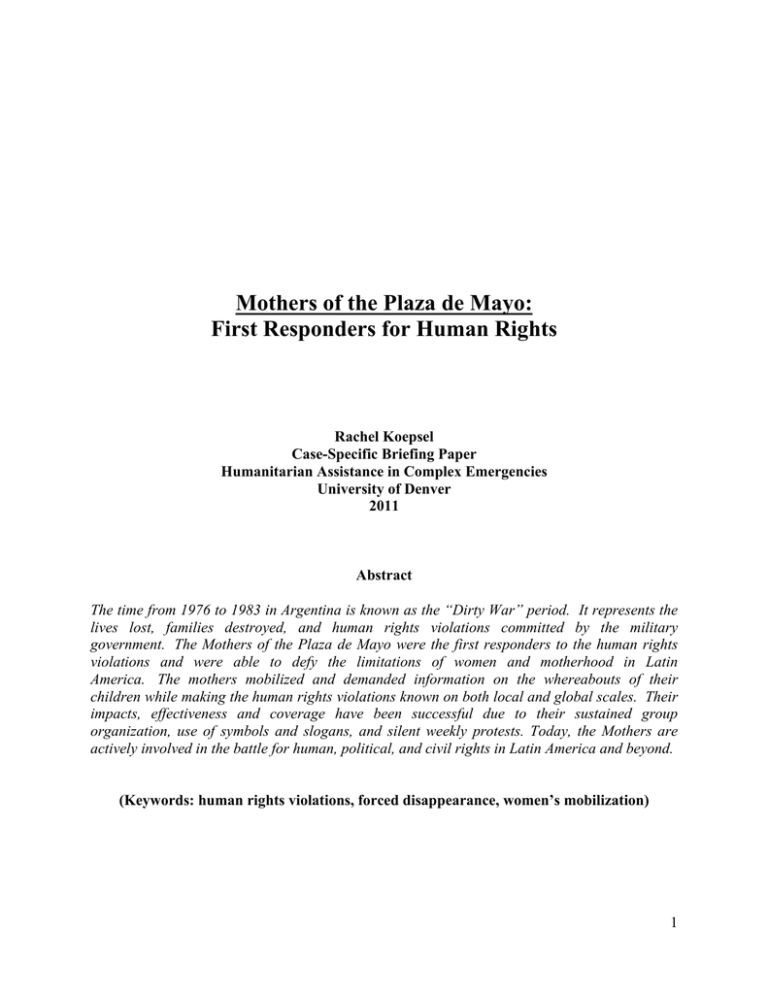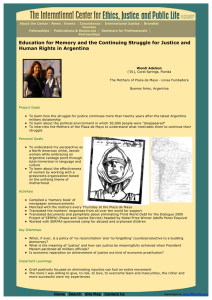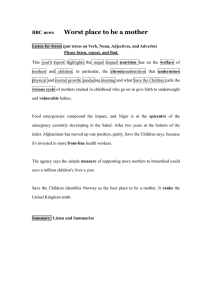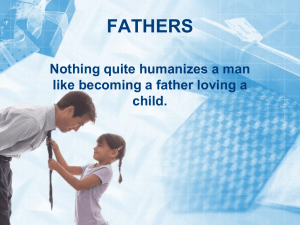Mothers of the Plaza de Mayo: First Responders for Human Rights
advertisement

Mothers of the Plaza de Mayo: First Responders for Human Rights Rachel Koepsel Case-Specific Briefing Paper Humanitarian Assistance in Complex Emergencies University of Denver 2011 Abstract The time from 1976 to 1983 in Argentina is known as the “Dirty War” period. It represents the lives lost, families destroyed, and human rights violations committed by the military government. The Mothers of the Plaza de Mayo were the first responders to the human rights violations and were able to defy the limitations of women and motherhood in Latin America. The mothers mobilized and demanded information on the whereabouts of their children while making the human rights violations known on both local and global scales. Their impacts, effectiveness and coverage have been successful due to their sustained group organization, use of symbols and slogans, and silent weekly protests. Today, the Mothers are actively involved in the battle for human, political, and civil rights in Latin America and beyond. (Keywords: human rights violations, forced disappearance, women’s mobilization) 1 Background: Human rights activists, victim’s families and writers refer to the period of time between 1976 and 1983 in Argentina as the “Dirty War” period, representing the lives lost, families destroyed, and human rights violations committed by the military government. This term was, and is, used to describe the undisclosed civil war taking place between the left wing supporters of reform and the Argentine Army backed by the right wing. The ultimate goal of the Dirty War was to “compel all people, by force and persuasion, to uphold a conservative national identity and patriarchal ideology.”1 Citizens in opposition to the military coup were considered to be conspirators of the government, dissidents and guilty of wanting to remove the country of its “harmony and unity.” Junta leaders of the army instilled antinationalist sentiments, communist ideologies and chaos in the general population in order to preserve the Argentine State. Overview: During the period of the Dirty War, anyone who verbally expressed their opposition to the military government or partook in related group discussions, violated the laws of the coup, or even casually spoke/criticized the coup vanished without a trace. It is believed that the Junta leaders, generals within the military government, were responsible for the disappearance of thousands of citizens of Argentina. • The estimates of disappeared persons during this time range from 30,000 to more than 45,000 and do not take into account the cases where entire families were kidnapped, leaving no one behind to report them as missing.2 1 Cynthia Bejarano, “Las Super Madres de Latino America: Transforming Motherhood by Challenging Violence in Mexico, Argentina and El Salvador,” Frontiers: A Journal of Women Studies 23(1)(2006): 146 2 Kathy Domenici and Karen Foss, “Haunting Argentina: Synedoche in the Protests of the Mothers of the Plaza de Mayo,” Quarterly Journal of Speech 87(3)(2001): 237 2 • The vast majority of those who disappeared were young, generally between the ages of 20 and 25, and were usually educated, politically aware and idealistic.3 In response to the disappearances, mothers in Buenos Aires were able to mobilize together despite their diverse backgrounds (geographic origins, economic and social classes, religion, political ideology, and gender orientation) to demand the truth about their children. In the case of Buenos Aires, the disappearances were a unifying catalyst for change. Together, the mothers of the disappeared created the organization, Asociación Madres de Plaza de Mayo (Association of the Mothers of the Plaza de Mayo) in 1977 and began to engage in peaceful protests to force the government to release information about their missing children. 4 • Every Thursday at 3:30 pm, The Madres continue their peaceful protests, which include marching around the Plaza de Mayo, located directly in front of the President’s residence (the Casa Rosada or Pink House), wearing their trademark white headscarves and carrying photographs of their children. • The Madres are still dedicated to denying the government an excuse to forget and move on without acknowledging its complicity and failure to bring the guilty to justice, but have also evolved to include exposing the abuses of other repressive regimes, working for human rights generally, and responding to injustices elsewhere.5 • Since the mobilization in 1977, the Mothers of the Plaza de Mayo has split into two groups, the original organization and Asociación Madres, Linea Fundadora, n.d. (Founding Line). 3 Malin, “Mother Who Won’t Disappear,” Human Rights Quarterly 16(1)(1993): 195 Domenici and Fross, “Haunting Argentina,” 237 5 Sally Webb Thornton, “Greif Transformed: The Mothers of the Plaza de Mayo,” Omega Journal 41(4)(2000): 286287 4 3 • The Founding Line is non-hierarchical and attempts to work with the government to find answers. It is interested in discovering the particular cause of death for each individual killed during the Dirty War. • The original organization is more hierarchical and strives to make sure offenders are punished while preserving the cultural memory of the Dirty War. It is committed to the struggle for human rights. Some members still believe their children are missing and not dead.6 Impacts: The traditional roles and responsibilities of women in Argentina were strictly confined within the home and workplace; women did not use their status as mothers for anything other than the proper upbringing of their children. The Mothers of the Plaza de Mayo were able to defy gender roles and collectively transform empowerment from mothers and housewives to the public sphere of motherist activism.7 The mothers claim their protests are grounded in the natural processes of family and motherhood that were disrupted by the human rights violations committed by the military government. Furthermore, they use the concept of Marianismo, the cult of feminine spiritual superiority and self-sacrifice that makes an ideal mother and wife in the Latin American tradition. This unique combination of cultural glorification and respect tied to motherhood makes the Mothers somewhat “untouchable,” and initially allowed them to demonstrate during a time when all protests were prohibited.8 They were able to use “motherhood” as a shield. This had profound impacts on many mothers in Argentine society. 6 Domenici and Fross, “Haunting Argentina,” 238-239 Bejarano, “Las Super Madres,” 126 8 Domenici and Fross, “Haunting Argentina,” 240 7 4 The Mothers broke down barriers within both public and private realms and released • mothers, generally, from lives that were “naturally determined” so as to enter into lives that were “socially determined,” allowing them to be subjects for – not merely the objects of – political action. Mothers became public figures; they showed themselves as ready to accept all risk inherited • in such rebellious activities. The occurrence of disappearances was not unique to Argentina. Since 1964 there have been over 90,000 governmental disappearances and killings in Latin America.9 After seeing how mothers in Argentina could make a difference when mobilizing together, women in other countries began to utilize their roles as mothers as forms of resistance – and were successful. Other mother-formed human rights movements took place in Chile (1973), as well as Brazil, • Uruguay, Guatemala and Honduras (late 1970s-early 1980s), and more recently in Sri Lanka (1990).10 Coverage: The Mothers were able to utilize an effective set of symbols in order to manage their personal trauma and grief while creating awareness for their disappeared children. When the organization was first formed, the Mothers wore white diaper kerchiefs on their heads to easily identify who were members of the group. As the organization progressed, the diapers became white handkerchiefs with the names and dates of the wearers’ disappeared children on the back. The handkerchiefs represent that the disappeared children are never forgotten. They also help raise awareness by initiating conversations with curious citizens who are interested in the significance of the handkerchiefs and become informed of the government’s human rights 9 Malin, “Mother Who Won’t Disappear,” 194. Malin, “Mother Who Won’t Disappear,” 200. 10 5 violations. Early on, this practice helped recruit new members to the organization, as other mothers who also had missing family members became aware of the Mothers of the Plaza de Mayo. The diaper and present-day handkerchiefs symbolize the most basic of human bonds and a missing generation.11 In addition to the handkerchiefs, the Mothers came up with the slogan, “Apracion con Vida” (Bring Them Back Alive) to represent their organization. The Mothers believe the slogan is a way of saying “no one has taken responsibility for their deaths because no one has said who killed them, who gave the order.” They argue that “if their children were taken without being charged with crimes, those who killed them should be found and brought to justice: [paradoxically] to admit and acknowledge their children’s death excuses those responsible. Thus many Mothers refuse to talk about their children as dead.”12 This slogan is embroidered on the backs of their handkerchiefs and calls attention to the disruption of the natural life cycle. Originally the Mothers decided to walk despite the clear and obvious violation of the military government’s laws against demonstrations. They chose the Plaza de Mayo where they would be unprotected in an enormous place in order show that they were willing to risk everything to learn what happened to their family members. Today, the Plaza de Mayo is tacitly acknowledged as belonging to the mothers.13 The Mothers transformed plazas across Argentina into key places where women can meet, develop friendships, share feelings, design strategies for future mobilization, and create networks visible to the general public.14 11 Domenici and Foss, “Haunting Argentina,” 243-245. Domenici and Foss “Haunting Argentina,” 245 13 Domenici and Foss, “Haunting Argentina,” 247. 14 Fernando J. Bosco, “The Madres de Plaza de Mayo and Three Decades of Human Rights’ Activism: Embeddedness, Emotions, and Social Movements. Association of American Geographers 96(2)(2006): 15. 12 6 • Plazas have been the key to sustainability of the movement over time because they became meeting areas and have contributed in helping the Mothers mobilize together over their feelings for their missing children. • When Mothers travel or move abroad, many of them will select a plaza in their new destination, adjust for the time difference and walk in the plaza (even if they are alone) “in parallel time,” to feel connected to their fellow Mothers who are doing the same back in Buenos Aires.15 • The Mothers have been able to maintain a feeling of proximity despite their physical distance and in spite of their large territorial network by recreating spaces of emotional intensity at the plazas in order to reinforce their collective gatherings, which helps replicate the movement across Argentina and abroad.16 Some mothers develop such strong connections with the Plaza de Mayo that they request their remains to be “interred” in the Plaza with their hermanas (sisters), placed around the monument in the center as a way to keep walking every Thursday and to not leave their fellow Mothers alone.17 The Plaza symbolizes more than just a meeting place and a sustainable tool of the Mothers. It further represents the “walking in circles” the Mothers did from government offices, police offices, and army facilities, to prisons seeking answers about their children. They would wait for hours without water, food or the use of sanitation facilities only to be told to return another day. The circle represents their never-ending activities and dedication to the return of their children.18 15 Bosco, “The Madres de Plaza de Mayo,” 17. Bosco, “The Madres de Plaza de Mayo,” 17. 17 Bosco, “The Madres de Plaza de Mayo,” 15. 18 Domenici and Foss, “Haunting Argentina,” 248. 16 7 Silhouettes and photographs were also utilized by the Mothers to spread coverage and awareness of the disappeared. Once a year, for 24 hours, the Mothers cut out and paint silhouettes and glue them to buildings, walls and trees around the cities. The empty silhouettes, some 30,000 of them, appear around Buenos Aires with the names and dates of missing people.19 Such an act reminds the Argentine society as well as the government that Mothers are still fiercely fighting against corruption and the accused torturers and assassins. The silhouettes do not “fill the emptiness, they only give it shape. And quantity.”20 For a day, the disappeared seemingly are more alive than the rest of the population. • Photographs are worn around the Mother’s necks when they march on Thursdays. They construct a powerful representation of the disappeared, showing the public that they are present in society through photographs, while at the same time absent.21 • The photographs not only remind society of the missing but also of this question: Could it happen again? Could it happen to their family? What kind of society are they living in that not only sanctions but initiates such abuses of human rights?22 • The Mothers were also able to provide coverage by putting their feelings into words. Many Mothers found comfort in writing poems about their experiences. Such poems were then complied into booklets and passed out around the city in order to create additional awareness.23 19 Malin, “Mother’s Who Won’t,” 202 Domenici and Foss, “Haunting Argentina,” 249. 21 Domenici and Foss, “Haunting Argentina,” 250. 22 Domenici and Foss, “Haunting Argentina,” 250. 23 Bosco, “The Madres de Plaza de Mayo,” 351. 20 8 Effectiveness: The Mothers effectively brought motherhood out of the domestic closet and showed how it can also be a social construct. They were able to create a new space of representation for women in the Argentine society. Furthermore, the Mothers were able to overcome the challenge that many social movements face; they have successfully sustained their organization for over 30 years and are still very active today.24 The Mothers of the Plaza de Mayo were the first to walk in protest to the military government. Since then, other groups of women throughout the country began to mobilize or form their own mother’s groups, and have since become chapters of the organization. The Mothers have been able to create a sustainable network throughout not only Argentina but abroad. Members of the organization are scattered in more than 20 cities across Argentina and promote awareness and fight for their causes together every Thursday (as noted above) at the same time as their sisters in Buenos Aires. Mother “support groups” are spread out across North America and Europe. The Mothers organization is particularly effective in sustaining such networks due to their linkage through a common cause, the disappearance of their children. They have created a complex web of interactions among individual members and formal organizational structures. Despite their separation into Mothers of the Plaza de Mayo and The Founding-Line, the organizations have been able to overcome their different views to often work together. This is possible since they first identify themselves, collectively, as “the mothers of the disappeared.”25 The Mothers therefore accomplished their goal of spreading awareness of the events that were taking place in the country and of actively working for human rights within their country 24 25 Bosco, “The Madres de Plaza de Mayo,” 351. Bosco, “The Madres de Plaza de Mayo,” 344. 9 and with other human rights organizations. Amnesty International came to publicize much of the information it received. The Netherlands and Canada became early supporters of the Mothers. After a Swedish-Argentine woman was disappeared by the coup, Sweden became one of the Mother’s biggest and strongest supporters abroad. President Jimmy Carter, after becoming aware of the human rights violations in Argentina through the Mothers, had the United States government investigate reports from the country. He ultimately made the decision to cut foreign aid to Argentina. The Mothers received further international support from Spain and Western European countries and were able to go abroad to share their stories and experiences. While in Italy, the Mothers met with President Sandro Pertini, who became a life-long supporter of their cause – and a friend.26 The Mothers also have been internationally recognized for their human rights struggles by world leaders and have addressed the United Nations.27 • The Mother’s activism has received the attention of many scholars such as Navarro (1989), Jelin (1990), Bouvard (1994), Taylor (1997), Eckstein (1989), Escobar and Alvarez (1992), and Dagnino (1998).28 • The Mothers effectively transformed symbols such as the white handkerchief, photographs, silhouettes, and slogans into tools of resistance and awareness that expose those responsible for or guilty of these atrocities to the scrutiny of the world.29 • The activism in Buenos Aires brought attention to human rights violations writ large. Documentaries were made. This productively and effectively created a means of disseminating mass information on the disappeared to thousands of people.30 26 Thornton, “Grief Transformed,” 284. Thornton, “Grief Transformed,” 288. 28 Bosco, “The Madres de Plaza de Mayo,” 343. 29 Bejarano, “Las Super Madres de Latino America,” 143. 30 Bejarano, “Las Super Madres de Latino America,” 142. 27 10 • A downtown office of the Associate of the Mothers of the Plaza de Mayo has been established as a place where Mothers can continue to coordinate their struggle.31 Following on comments made earlier, the Mothers have inspired other groups to arise. Las Abuelas de la Plaza de Mayo (Grandmothers of the Plaza de Mayo) also are dedicated to locating the children of the disappeared and restoring them to their legitimate families. As well, they work to guarantee children’s rights so that the removal of children will not happen in the future. Another group that has formed in Argentina is HIJOS (Children). Also a human rights organization, it emerged after being inspired by the Mothers; it is dedicated to uniting the children of the disappeared in order for them to meet others like themselves. The members are also interested in fighting laws that grant protection for those responsible for the disappearances during the Dirty War.32 Today, Mothers of the Plaza de Mayo, Abuelas, HIJOS and The Founding-Line are able to work together and effectively accomplish similar goals. Summary: Today, the Mothers are actively involved in the battle for human, political and civil rights in Argentina, elsewhere in Latin America, and beyond.33 While they are still fighting to accomplish their main goal of finding information on their missing children, they have successfully inspired mothers and other women elsewhere to mobilize together and fight for a common cause. They have defied the stereotypical limitations of women and motherhood in Latin America and have expanded their activism to human rights violations against indigenous people, law- and policy-making, and gaining representation and respect in societies. Symbolism and perseverance are keys.34 The Mothers, in a real sense, were the first responders to the human 31 Bosco, “The Madres de Plaza de Mayo,” 353. Domenici and Foss, “Haunting Argentina,” 239. 33 Bosco, “The Madres de Plaza de Mayo,” 361. 34 Bejarano, “Las Super Madres de Latino America,” 132-133. 32 11 rights violations committed during the Dirty War and have been able to make the violations known on a local and global scale. The Mothers were able to overcome fear and stand up for their missing children. Since their mobilization in 1977 and subsequent work, there have been no further governmental disappearances in Argentina. 12 Bibliography: Bejarano, Cynthia L. 2002. “Las super madres de latino america: Transforming Motherhood by Challenging Violence in Mexico, Argentina, and El Salvador.” Frontiers: A Journal of Women Studies 23 (1): 126-50. Bosco, Fernando J. 2006. “The Madres de Plaza de Mayo and Three Decades of Human Rights’ Activism: Embeddedness, Emotions, and Social Movemements.” Annals of the Association of American Geographers 96(2): 342-62. Foss, K.A. and K.L. Domenici. 2001. “Haunting Argentina: Synecdoche in the Protests of the Mothers of the Plaza de Mayo. Quarterly Journal of Speech 87(3): 237-58. Malin, Andrea. 1994. “Mother Who Won't Disappear.” Human Rights Quarterly 16 (1): 187. Thornton, S.W. 2000. “Grief Transformed: The Mothers of the Plaza de Mayo. Omega: Journal of Death and Dying 41(4): 279-89. 13



